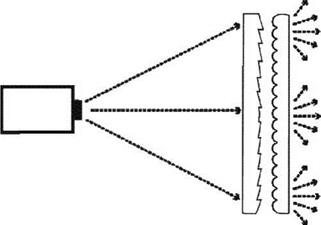In addition to the Fresnel lens element, there is a light dispersion screen element (either a lenticular, cross-lenticular, or diffusion-like screen). The Fresnel lens ensures perfect brightness uniformity across the screen surface, and the light dispersion element distributes the image into the viewing area. Designs are available both with symmetric and differentiated (horizontal and vertical) light dispersion. Two – element optical screens are available with a true contrast filter that actively absorbs the ambient light in the room, while still allowing all projected light to be transmitted (bead screens, black stripe screens). These screens show excellent resistance to room lighting (Figure 4.28).
4.5.7 Selection of Rear Projection Screens
Two-element screens are typically the most common choice for a large projection display wall. This is simply because it is important to have high contrast (readability) and good uniformity all over the display. These are also the most expensive screens to use for these applications and therefore all the screen types find their way to the display wall installation from time to time. But, of course, the overall performance of the display needs to be matched to the requirement of the application: detail readability, contrast, viewing angles/brightness, colour and brightness uniformity, and so forth (Table 4.2).
One of the most important components in a rear projection display—together with the electronics—is the screen. In order to have a perfect image, the use of a high-end screen is indispensable. Today the most widely used screen in the market of control rooms is the Black Bead screen from dnp. This screen has excellent characteristics and perfect quality for this kind of application.
|
FIGURE 4.28 Projected image from a dual-element optical screen. |
|
Table 4.2 Advantages and Disadvantages of Rear Projection Screens
|
With rear-projection cubes it is necessary to distinguish between two technologies: (1) the projection with LCD-based projection engines and (2) with DLP-based projection engines.




